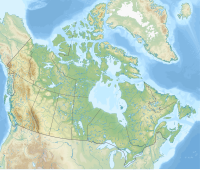Mount Aberdeen (Alberta)
| Mount Aberdeen | |
|---|---|
 Mount Aberdeen as seen from the Plain of the Six Glaciers trail | |
| Highest point | |
| Elevation | 3,152 m (10,341 ft)[1][2] |
| Prominence | 566 m (1,857 ft)[3] |
| Parent peak | Mount Lefroy (3442 m)[3] |
| Listing | Mountains of Alberta |
| Coordinates | 51°22′48″N 116°14′51″W / 51.38°N 116.2475°W[4] |
| Geography | |
| Country | Canada |
| Province | Alberta |
| Protected area | Banff National Park |
| Parent range | Bow Range |
| Topo map | NTS 82N8 Lake Louise[4] |
| Geology | |
| Age of rock | Cambrian |
| Type of rock | Sedimentary rock |
| Climbing | |
| First ascent | 1894 Samuel E.S. Allen, L.F. Frissel, Walter D. Wilcox[3][5] |

Mount Aberdeen is a 3,152-metre (10,341-foot) mountain summit located in the Lake Louise area of Banff National Park, in the Canadian Rockies of Alberta, Canada. Its nearest higher peak is Mount Lefroy, 2.9 km (1.8 mi) to the southwest. Haddo Peak is on the same massif with Mount Aberdeen, and the Aberdeen Glacier is between the two peaks.[2]
History[edit]
Mount Aberdeen was named by James J. McArthur in 1897 for Lord Aberdeen, 7th Governor General of Canada.[6] Prior to 1897 it was known as Hazel Peak, but there is no record of who Hazel was.[1]
The first ascent of the peak was made in 1894 by Samuel E.S. Allen, L.F. Frissel, and Walter D. Wilcox.[3][5] In 1917, V.A. Flynn reached the summit by traversing from the top of Haddo Peak with a descent to the Aberdeen Glacier and then up over steep snow and an ice arête.[5]
The mountain's name was made official in 1952 by the Geographical Names Board of Canada.[4]
Geology[edit]
Like other mountains in Banff Park, Mount Aberdeen is composed of sedimentary rock laid down during the Precambrian to Jurassic periods.[7] Formed in shallow seas, this sedimentary rock was pushed east and over the top of younger rock during the Laramide orogeny.[8]
Climate[edit]
Based on the Köppen climate classification, this mountain is located in a subarctic climate zone with cold, snowy winters, and mild summers.[9] Temperatures can drop below −20 °C (−4 °F) with wind chill factors below −30 °C (−22 °F).
See also[edit]
References[edit]
- ^ a b "Mount Aberdeen". cdnrockiesdatabases.ca. Retrieved 2019-08-28.
- ^ a b "Topographic map of Mount Aberdeen". opentopomap.org. Retrieved 2021-03-26.
- ^ a b c d "Mount Aberdeen". Bivouac.com. Retrieved 2008-12-20.
- ^ a b c "Mount Aberdeen". Geographical Names Data Base. Natural Resources Canada. Retrieved 2018-12-17.
- ^ a b c Thorington, J. Monroe (1966) [1921]. "Vermilion Pass to Kicking Horse Pass". A Climber's Guide to the Rocky Mountains of Canada. With the collaboration of Putnam, William Lowell (6th ed.). American Alpine Club. pp. 83–84. ISBN 978-1376169003.
- ^ Place-names of Alberta. Ottawa: Geographic Board of Canada. 1928. p. 9.
- ^ Belyea, Helen R. (1960). The Story of the Mountains in Banff National Park (PDF). parkscanadahistory.com (Report). Ottawa: Geological Survey of Canada. Archived (PDF) from the original on 2015-10-02. Retrieved 2019-09-13.
- ^ Gadd, Ben (2008). Geology of the Rocky Mountains and Columbias.
- ^ Peel, M. C.; Finlayson, B. L.; McMahon, T. A. (2007). "Updated world map of the Köppen−Geiger climate classification". Hydrol. Earth Syst. Sci. 11: 1633–1644. ISSN 1027-5606.
External links[edit]
 Media related to Mount Aberdeen at Wikimedia Commons
Media related to Mount Aberdeen at Wikimedia Commons- Parks Canada web site: Banff National Park


